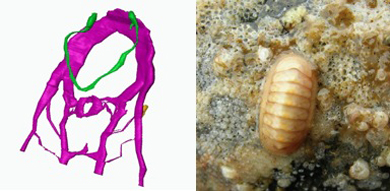How do sea creatures see their world? Following a joint global researcg project, a new sense organ has been discovered in ancient deep-sea molluscs. Scientists working in Queen’s University Belfast and Munich have discovered a sensory organ totally new to science, in research published this week. Chitons are small marine animals covered by eight shell plates and found in oceans all over the world. They are often called “living fossils”, as they look the same as their ancestors from 300 million years ago.
[caption id="attachment_46839" align="alignleft" width="390"] Marine scientists at Portaferry’s QUB research centre are over the moon with the chitin research discovery.[/caption]
Marine scientists at Portaferry’s QUB research centre are over the moon with the chitin research discovery.[/caption]
The “Schwabe organ” (named after its discoverer) is a stripe of dark pigmentation found either side of the mouth, present in every member of an extremely old, deep-sea group of chiton species. Until now, it was thought that these animals were so basic and primitive that they lacked even a brain, but the new findings challenge these ideas.
The deep sea, once thought to be empty and barren, is home to many weird and wonderful creatures such as angler fish, yeti crabs and giant tube worms. Deep-sea molluscs range from minute slugs to highly intelligent giant squid. But what is special about this particular mystery of the deep is that some species of these “Leptochitons” have crawled their way onto the shores of Europe and North America, too. The team have been working together on this project for almost five years, in Canada, Germany, and Northern Ireland, and their story already spans two academic “generations”. Enrico Schwabe, a researcher at the Bavarian State Collection, Germany, first noticed the pigment and could not find any previous records of it. Intrigued, he sent photographs to Dr Julia Sigwart of the Queen’s University Marine Laboratory, who was writing a thesis on deep-sea chitons at the time, and together they started to investigate the mystery pigment patch. Dr Sigwart now has a PhD student of her own, Lauren Sumner-Rooney, who has finally brought the study to its conclusion that Schwabe had in fact discovered a brand new sensory organ. Dr Sigwart said: “Using cutting-edge technology, the group produced a digital 3D model of the chiton nervous system to understand how the Schwabe organ fits. Then, electron microscopes were used to examine the mystery pigment patch, and the team proved that it is full of nerves: a sense organ. This is positive proof that the patches are sensitive. Pigment is usually associated with light-sensing organs, like eyes or eyespots.”
“But these animals live in the deep sea, on rocks, often buried in the sand at the bottom of the ocean. So light detection seems unlikely,” explained Lauren Sumner-Rooney, “but we’re keeping our minds open as we design new experiments.” The purpose of the new sense organ remains a mystery, for now. “The new sense organ is clearly visible in the living animals, once you know it’s there, and occurs in more than 100 species – but it was never before described in more than a century of detailed study. So not only is this an exciting discovery for neuroscience, but also shows how many mysteries remain in the sea.
“This truly reminds us how much more is out there waiting to be discovered. It’s been amazing for me to be part of this study, at the very frontiers of our knowledge. The next step for the team will be to secure funding to determine the function of the new sense organ.”
]]>

























